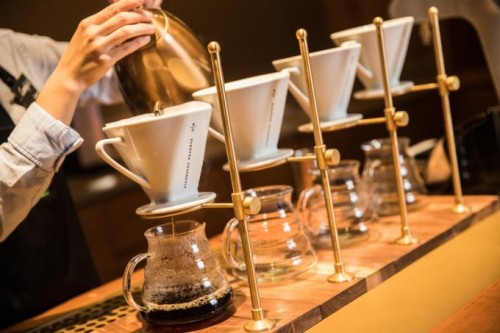With the third wave of coffee revolution, China's coffee market will usher in a new round of local changes.

For professional baristas, please follow the coffee workshop (Wechat official account cafe_style)
/ Zhu Danpeng / tr. by Phil Newell)
"I'm not at home, I'm in the cafe; I'm not in the cafe, I'm on my way to the cafe." Balzac who said this drank 50,000 cups of coffee in his life.
Nowadays, coffee has become one of the most popular drinks in the world.
According to Euromonitor statistics, except for a few Asian countries, coffee is more popular in most countries around the world.
At the same time, in China, coffee will usher in a round of development dividend.
The 10 billion-level market ushered in the development dividend
According to the report on Investment Analysis and Prospect of China's Coffee Industry from 2017 to 2021 released by China Consulting Investment Network, China's coffee consumption is growing at an annual rate of 15% to 20%. The average global coffee consumption growth rate is only 2%.
Although the average amount of coffee consumed per person in China is less than 5 cups per person per year, in first-tier cities such as Shanghai, Beijing and Guangzhou, per capita coffee consumption is 20 cups per year.
At the same time, the annual per capita coffee consumption in North American and European countries is about 400 cups, while that in Japan is about 360 cups.
By contrast, even China's first-tier cities differ from other countries' annual per capita coffee consumption by more than single digits, so China still has a lot of room for growth.
Sales of ready-to-drink coffee in China increased by 19% in 2016, according to the Euromonitor report. With the popularization of coffee culture, the accelerated development of urbanization and the acceleration of the pace of life, the demand for coffee is increasing.
According to Euromonitor, China's ready-to-drink coffee market share will reach 14.9 billion yuan in 2021, obviously, this is a 10 billion-level market, this figure does not include coffee shop consumption. Some people in the industry once said: "Coffee is in its infancy in China and will maintain double-digit growth in the next 10 years."
Market potential stimulates brand layout
The potential of China's coffee market is like an unexploited gold mine, the huge market has attracted the attention of more and more brands, coffee market shows the characteristics of rapid growth of the industry and enthusiasm of enterprises.
In mid-September last year, Starbucks teamed up with Master Kang to launch four bottled Frappuccino products that meet the tastes of Chinese consumers, focusing on supermarkets, convenience stores and e-commerce.
In this cooperation, Starbucks is responsible for product research and development, while Kang Shifu is responsible for production and sales. The joint efforts of the two giants will certainly upset the instant coffee market. Beverage boss Wa has also launched Maoyuan Coffee as the first new product in 2016. Coca-Cola is also introducing Joya Coffee to try to get a piece of the pie.
I don't know if you have noticed that there have been some landmark moves in the coffee industry this year.
At the end of July, coffee giant Starbucks announced that it would buy the remaining 50 per cent of its joint venture with Uni-President in eastern China for $1.3 billion, completing the historic acquisition and launching the world's second baking factory in Shanghai. Recently, COSTA parent company UK Whitbread Group also announced The remaining 49 per cent of Yueda Shijia (Shanghai) Restaurant Management Co., Ltd., a joint venture with Jiangsu Yueda Group, was acquired for 310 million yuan, giving COSTA full ownership of the southern Chinese market, followed by Peet's 's official entry into China.
At the same time, we must not ignore the movements of Nestl é. He launched the first instant coffee in 1938 and the first capsule coffee machine in 1986. Food giant Nestle Group has become one of the largest coffee brands in the world through continuous innovation.
Nestl é, with its instant coffee brand Nestle Coffee and capsule Coffee maker Nespresso, accounts for 23% of the global $77 billion coffee retail market, according to data. At the same time, Nestl é, as one of the earliest coffee brands to enter the Chinese market, has a solid foundation in the market and a strong brand. In 2016, Nestle Coffee accounted for 68% of China's total ready-to-drink coffee sales, making it the absolutely leading brand in the market share.
Not long ago, Nestl é surprised the industry by spending $500m to become the largest shareholder in niche coffee brand Blue Bottle. Who is Blue Bottle? he is a super niche, refreshing, geek, Silicon Valley favorite coffee brand. To what extent is this brand niche? It has coffee shops in only four cities in the United States. After the news broke, even the American media blew up. Reuters even published a report entitled "Nestl é began to make high-end coffee after buying Blue Bottle."
The third wave of the coffee revolution came.
The combination of these events proves a trend that China's coffee market will usher in a new round of changes in the next two or three years. Why do you say that? we have to review the history of coffee.
In the 1980s, the classic slogan "Nestle, delicious" spread all over the streets. as the enlighteners of coffee, Nestl é and Maxwell brought this kind of instant coffee into thousands of households at low prices, achieving the first revolution in the coffee industry.
After that, consumers also want to use coffee as the communication medium and cafes as dating places. So, driven by consumer demand, Starbucks, Costa and other stores have opened stores all over the world, lattes, American style, cappuccino and so on come into our lives. Perhaps as linguist Samuel Johnson said, a cafe is an idea, a way of life, a social model, a philosophy. Drinking coffee has become a fashion, and going to Starbucks to take selfies has become the standard of Wenqing, which is the second revolution in the coffee industry.
Since then, after the advent of instant coffee and the debut of coffee chains, boutique coffee shops have become increasingly popular on the west coast of the United States. This kind of high-quality coffee shop, which is particular about purchasing and brewing coffee beans, is called the third wave in coffee history. As one of the world's largest food companies, Nestl é is accelerating its presence in the coffee market. Not long ago, he spent $500m to become the largest shareholder in the niche coffee brand Blue Bottle, where coffee is like a work of art, with an emphasis on quality control in every step from source planting to handmade. Nestle's move clearly signals the arrival of the third wave of the coffee revolution.
Revolution is related to the upgrading of consumption
So what is the logic behind this revolution is clearly related to the upgrading of consumption.
In the whole process of consumption upgrading, with the expansion of the middle class and the rise of the new generation, coffee has been integrated into the daily consumption elements of Chinese consumers, which reflects the general trend of diversification of the whole market.
Of course, the most important thing is the change in the consumption structure. Statistics show that the number of cafes in China exceeded 100000 in 2016, and the market growth rate is as high as 16%, far exceeding the world average. The nurtured Chinese coffee consumption market is gradually moving closer to the overall global trend. The consulting firm Yintmin predicts that in the next two years, the market share of instant coffee in China's coffee consumption market will decline, and the current ground coffee will grow rapidly. This may be why Nestl é acquired niche coffee brand Blue Bottle, Starbucks and COSTA gradually realized direct management of stores in mainland China, and even set expansion plans to achieve 5000 and 700s respectively in 2021.
GE Wen, senior vice president of Nestl é Greater China Coffee Business Unit, said in an interview with the media that as a leading brand in the field of coffee, Nestl é has been trying to provide customers with different products, including instant coffee, ground coffee, capsule coffee and gold coffee, and provide them with different product portfolios according to their different needs.
At the same time, in the face of the sound of bad instant coffee, GE Wen even laid out the data to attack: "China's instant coffee market has been growing in each of the past three years, and it has a large base, even single-digit growth is very objective." In his view, different forms of coffee will grow in the future, and one of the market breakthroughs for coffee can be to focus on the third and fourth tier markets to cultivate consumers. From the perspective of consumption habits, most consumers who are new to coffee start from instant coffee and instant coffee. Therefore, the category growth of coffee in the future will show the characteristics of structure and diversification.
Of course, the spending power of the new generation is rising. Their consumption power is gradually increasing, and they want personality, freshness and quality. Survey data also show that consumers between the ages of 25 and 39 are much more enthusiastic about going to chain coffee stores than other age groups. Boutique coffee represents a trendy way of life, and there are more and more followers.
At the same time, their consumption logic has also changed, the appearance of the product is pleasant, the consumption scene is comfortable is also the reason to pay for it. When consumers change from listeners to communicators, participating in or throwing out topics they are interested in may be an effective way to catch the target consumers. On September 22nd, Nestle Coffee "sense CAFE" flash store opened in Beijing, and invited the image spokesman Li Yifeng platform. This is the first time that Nestle Coffee has opened a flash coffee shop in China since it entered China nearly 30 years ago. GE Wen said that the pop-up coffee shop is one of the new experiences that Nestl é provides to consumers, and at the same time, companies have recently sold products around some brands in WeChat Mall, hoping to have more participation and interaction with young consumers in some new ways in the future. Whether in the form of a pop-up coffee shop or otherwise, Nestl é wants to be as close to consumers as possible and get in touch with them very deeply.
Obviously, the consumption target group is younger, looking for the intersection of their own brand characteristics and young people, so that more young consumers feel and like the quality coffee and culture they provide is the way for enterprises to win in the future. In the face of the market competition pattern and the changes of consumers, the endless marketing activities need to be used by young consumers. For example, COSTA regularly opens coffee classrooms to teach coffee knowledge, allowing baristas to go to customers, show their enthusiasm and personality, express their pride as baristas, and help consumers popularize coffee expertise is a far-sighted move.
Source: China Business Daily
Original title: the third round of coffee development dividend is coming.
Important Notice :
前街咖啡 FrontStreet Coffee has moved to new addredd:
FrontStreet Coffee Address: 315,Donghua East Road,GuangZhou
Tel:020 38364473
- Prev

Why can you concentrate in the coffee shop but not in the office?
Communication of professional baristas Please follow the coffee shop (official Wechat account cafe_style) people often like to work in coffee shops because the office is too noisy and interfering, but the coffee shop is not particularly quiet, why can't people go to the coffee shop and concentrate in the open room office? People often find the open space of the office noisy and easily distracted, and like to go to the office with a computer.
- Next

The third Yunnan Coffee Cup China Cooking Competition was held in Dalian.
For the exchange of professional baristas, please follow the coffee workshop (official Wechat account cafe_style). Recently, the Northeast Division Competition of the third Yunnan Coffee Cup China Brewing Competition was held in Dalian Commercial School. Yunnan Coffee Cup Brewing Competition is one of the top hand-brewing coffee competitions in China sponsored by the Agricultural Department of Yunnan Province. it is now the third year, and it has provided countless coffee people with opportunities to show themselves.
Related
- A complete list of coffee bean names and their meanings! What is Yejia Shefi coffee? Where is Mantelin coffee?
- What grade does Arida Manor Kaduai coffee beans belong to? What treatment is Arida ASD slow anaerobic sun exposure?
- The milk tea cup becomes smaller?! Overlord Tea Girl launches a new "Return to Yunnan" series
- Accused of selling counterfeit and high-priced coffee beans! Well-known boutique coffee brand "Oukelao" bowed and apologized!
- How to make espresso dumplings? Can I eat coffee and glutinous rice balls together?
- Save the unformed and stagnant powder cakes in one second! What is the problem with stagnant water in the powder bowl of the espresso machine?
- What does hand-brewed coffee stop mean? Why is it not recommended to make coffee by hand?
- Is it normal to smell like coffee? Why does coffee smell like alcohol? What's wrong with the strong smell of cold extract ice dripping ice brewed coffee?
- How to solve the problem that hand-brewed coffee extraction takes too long? Why is the water flowing so slowly when making coffee?
- The main points of making Australian white coffee, the proportion details, how does Australian white properly foam and blend the flowers?

